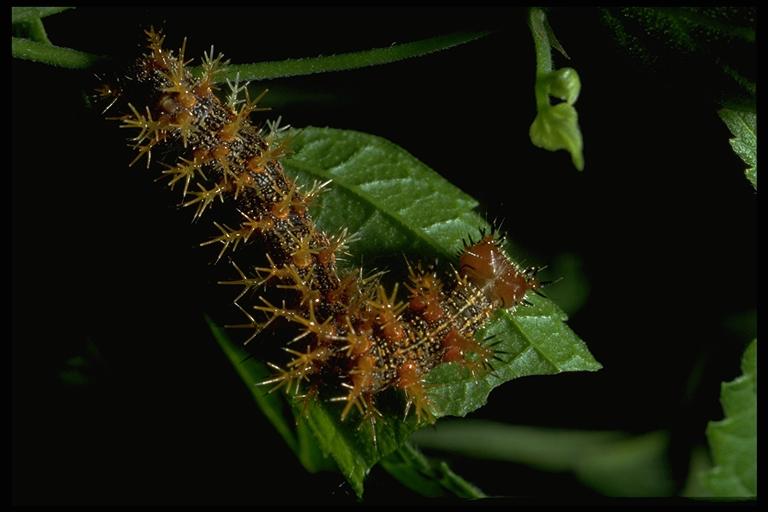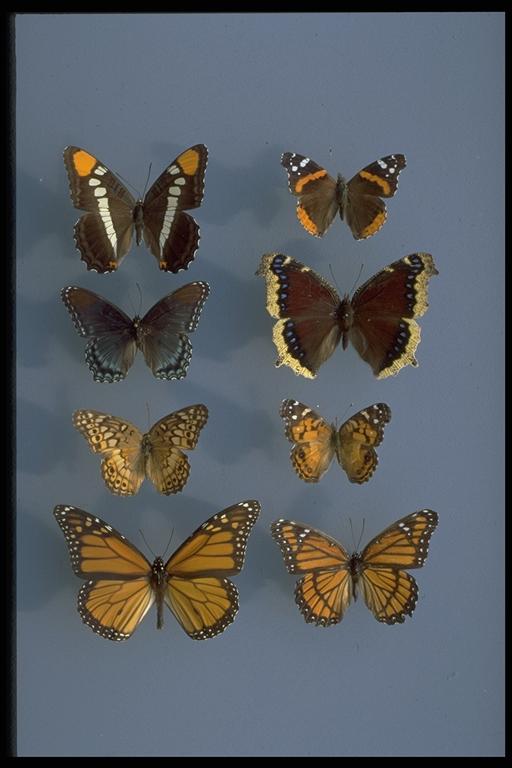
Buckeye, Junonia (Precis) coenia (Hübner) (Lepidoptera: Nymphalidae). Photo by Drees.
Common Name: Buckeye
Scientific Name: Junonia (Precis) coenia (Hübner)
Order: Lepidoptera
Description: This medium sized brushfooted butterfly, with a 1- ½ to 2-½ inch wingspan, is overall yellow-brown from above, but has two prominent intricately-colored eyespots on each of the fore and hind wings and additional white, red and marginal markings. Caterpillars are shiny black with two rows of orange spots on the back, two rows of cream spots one the sides. The false legs (prolegs) on abdominal segments are orangish and the body is adorned with black branched spines with blue bases on the back and orange bases on the sides. The head is orange and bears a pair of spines.
In southern Texas, a darker subspecies, Junonia (Precis) coenia nigrosuffusa (Barnes & McDunnough), and another similar species, Junonia (Precis) evarete (Cramer), with smaller eyespots, occur. These species are sometimes migratory. The family Nymphalidae contains butterflies called “brushfooted” butterflies because their front pair of legs is reduced. This is the largest butterfly family, with 73 species found in Texas including fritillaries, checker spots, crescents and others. Other
common and distinctive species of moderately-sized brushfooted butterflies are the variegated fritillary, Euptoieta claudia, a yellow-brown butterfly with upper wing surfaces marked with darker brown lines and spots along a double dark-lined wing margins (2 1/4 inch wingspan); the American painted lady, Vanessa virginiensis (Drury), an orangeish butterfly with white spots and markings at the tips of the forewings in blackened areas and black-ringed blue spots and dark lines along the hind wing margins (2 inch wingspan); red admiral, Vanessa atalanta (Linnaeus), a brown-black butterfly marked with a brilliant red band that encircles the front wings and follows the margins of the hindwings, and with white markings on the tips of the fore wings (2 inch wingspan); the red-spotted purple, Basilarchia (Limenitis) arthemis (Drury), a blue-black butterfly with iridescent blue to blue-green markings along the white-marked, scalloped wing margins (2 3/4 inch wingspan); and the viceroy, Bacilarchia (Limenitis) archippus (Cramer), a butterfly superficially similar to the Monarch butterfly, Danaus plexipus (Linnaeus) (Lepidoptera: Danaidae), but quickly distinguished by the presence of a black mid-wing crossband on the upper surface of the hind wings on the viceroy (3 inch wingspan).
Life Cycle: Larvae and adults overwinter. Female butterflies lay eggs on host plants and caterpillars develop through several stages (instars) before forming a chrysalis (pupa). Three to four generations are produced annually.
Habitat and Food Source(s): Caterpillars have chewing mouthparts. Adults have siphoning mouths. Caterpillars eat leaves of broad-leaved weeds including gerardia, false loosestrife, monkey flower, plantain, snapdragon, stonecrop, toadflax and Verbenaceae. Butterflies are found in open areas where they make shots flights between stops where they rest on the ground, holding their wings out while basking. Adults frequent flowers and feed on nectar.

Red admiral, Vanessa atalanta (Linnaeus) (Lepidoptera: Nymphalidae), larva.
Photo by Drees.
Pest Status: Harmless
See also Butterfly Gardening in Texas.
For additional information, contact your local Texas A&M AgriLife Extension Service agent or search for other state Extension offices.
Literature: Howe 1975; Neck 1996; Wright 1993.
